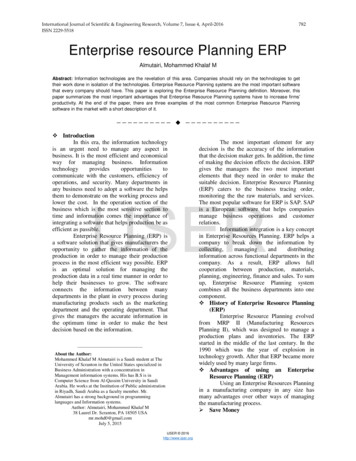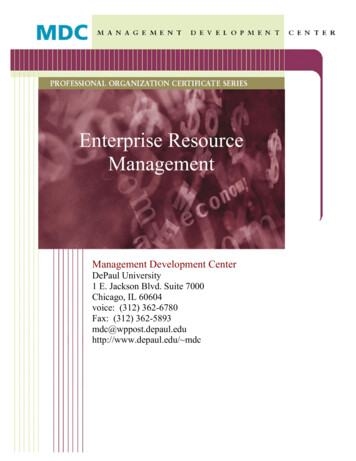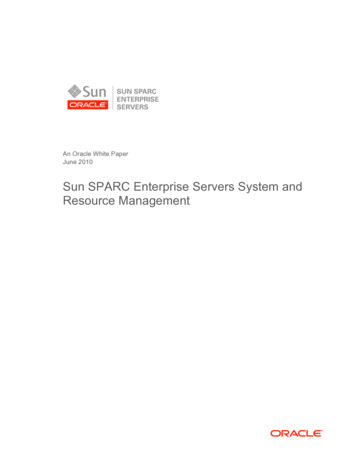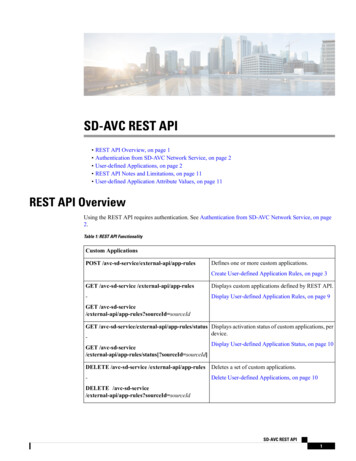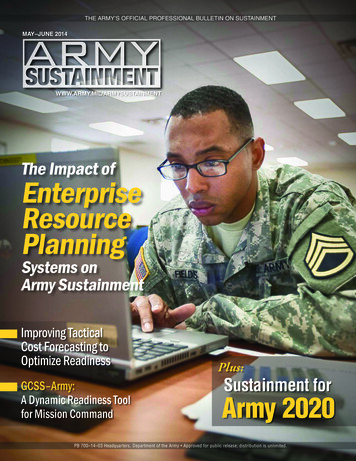
Transcription
THE ARMY’S OFFICIAL PROFESSIONAL BULLETIN ON SUSTAINMENTMAY–JUNE 2014WWW.ARMY.MIL/ARMYSUSTAINMENTThe Impact ofEnterpriseResourcePlanningSystems onArmy SustainmentImproving TacticalCost Forecasting toOptimize ReadinessGCSS–Army:A Dynamic Readiness Toolfor Mission CommandPlus:Sustainment forArmy 2020PB 700–14–03 Headquarters, Department of the Army Approved for public release; distribution is unlimited.
TABLE OF CONTENTSON THECOVERTHE ARMY’S OFFICIAL PROFESSIONAL BULLETIN ON SUSTAINMENTMAY–JUNE 2014WWW.ARMY.MIL/ARMYSUSTAINMENTThe Impact ofFEATURES10 Improving Tactical Cost Forecasting to Optimize ReadinessWhat obstacles exist to forecasting tactical costs, and how can the Army optimizereadiness in an environment of fiscal uncertainty? By Col. E. Deacon Maddox23 Global Combat Support System–Army: A Dynamic Readiness Tool forMission CommandImplementing GCSS–Army requires a completely new mindset for all involvedin sustainment, beginning with leaders. Preparing to integrate GCSS–Armyinto sustainment operations requires specific training and planning to ensuresuccess. By Capt. Mei-Ling Guarino26 Sustainment for the Army of 2020The Combined Arms Support Command proposed a new division-aligned forcestructure to provide sustainment capabilities from echelons above brigade usingcombat sustainment support battalions. By Col. Robert Hatcher, Jeffrey A. Martin, and Lt. Col. Karl F. Davie BurgdorfFOCUS2 The Impact of Enterprise Resource Planning Systems on Army SustainmentEnterprise resource planning systems improve equipment management, partsand supply ordering, and financial accountability while providing visibility ofequipment in the supply pipeline. By Maj. Gen. Larry D. WycheEnterpriseResourcePlanningSystems onArmy SustainmentImproving TacticalCost Forecasting toOptimize ReadinessGCSS–Army:A Dynamic Readiness Toolfor Mission CommandPlus:Sustainment forArmy 2020PB 700–14–03 Headquarters, Department of the Army Approved for public release; distribution is unlimited.Pfc. Kinney Fields takes a finalexam using the Global CombatSupport System (GCSS)–Armyduring advanced individualtraining at Fort Lee, Va., April 24,2014. GCSS–Army training hasbeen implemented in initial-entrytraining and professional militaryeducation to ensure units have arobust knowledge base before theyreceive the system.(Photo by FredW. Baker III)DEPARTMENTS“Global CombatSupport System–Armywill benefit the entireforce.”Maj. Gen. Larry D. WycheThe Impact of Enterprise ResourcePlanning Systems onArmy Sustainment, p. 2.COMMENTARY5 Mission Command: The Starfish and the SpiderDr. Christopher R. Paparone and George L. Topic Jr.6 Train as We Fight: Using Sustainment Vehicles for Convoy ProtectionLt. Col. William Kepley and Stephen HarperFEATURES15 Leveraging Information for a Competitive AdvantageCol. Jeffrey C. Powell19 Separating Resource Management From Finance OperationsGina Smith
OPERATIONS32 Establishing the Afghanistan Transportation NetworkCapt. Warren R. CrockerTRAINING AND EDUCATION34 Logistics Simulations for Battle Staff TrainingKathryn Bailey and Calvin Pilgrim37 Sustainment Synchronization: Key to Supporting Operational UnitsCapt. David A. Wallace39 Supporting Task Force LiftCapt. Carlos M. Sanford, 1st Lt. Ryan C. Cloud, and1st Lt. Timothy D. Hryniewicz42 Forward Support Company Operations in Separate UnitsCapt. Thomas A. KnotheTOOLS44 Improving Materiel Fielding on the Korean PeninsulaMaj. Timothy J. Barrett47 BUILDER: Condition-Based Maintenance for FacilitiesNadia Abou-El-Seoud and Claude Matsui49 A Repair Versus Replace Maintenance CultureChief Warrant Officer 4 Steven Dewey52 The Visibility of Integrated Tactical Logistics ProjectGrady M. EmbreyMembersLt. Gen. Raymond V. MasonDeputy Chief of Staff, G–4Department of the ArmyLt. Gen. Michael E. WilliamsonPrincipal Military Deputyto the Assistant Secretary of the ArmyAcquisition, Logistics, and TechnologyLt. Gen. Patricia E. McQuistionDeputy Commanding GeneralArmy Materiel CommandLt. Gen. Joseph E. MartzMilitary Deputy for Budget to theAssistant Secretary of the ArmyFinancial Management and ComptrollerLt. Gen. Patricia D. HorohoThe Army Surgeon GeneralEx Off icioBrig. Gen. John E. O’Neil IVThe Quartermaster GeneralBrig. Gen. John “Jack” HaleyChief of OrdnanceBrig. Gen. John P. SullivanChief of TransportationBrig. Gen. Paul ChamberlainCommanderArmy Soldier Support InstituteBrig. Gen. Theodore “Ted” C. HarrisonCommanding GeneralArmy Expeditionary Contracting CommandMaj. Gen. (Dr.) Joseph Caravalho Jr.Commanding GeneralArmy Medical Research and Materiel CommandARMY LOGISTICS UNIVERSITYJohn E. HallPresidentHISTORY54 Getting There Was the Battle: Part IIDavid J. RohrerCivilian DeputyDr. James P. Herson Jr.PB 700–14–03VOLUME 46, ISSUE 3May–June 2014ChairmanMaj. Gen. Larry D. WycheCommanderCombined Arms Support CommandCol. Robert A. Harney Jr.Commandant/Military DeputyPHONE: (804) 765–4755 (DSN 539–4755)EMAIL: USARMY.LEE.TRADOC.MBX.LEEEASM@MAIL.MILWEBSITE: WWW.ARMY.MIL/ARMYSUSTAINMENTArmy Sustainment (ISSN 2153–5973) is a bimonthlyprofessional bulletin published by the Army Logistics University, 2401 Quarters Road, Fort Lee, Virginia 238011705. Periodicals postage is paid at Petersburg, VA23804–9998, and at additional mailing offices.Mission: Army Sustainment is the Department of theArmy’s official professional bulletin on sustainment. Itsmission is to publish timely, authoritative information onArmy and Defense sustainment plans, programs, policies,operations, procedures, and doctrine for the benefit of allsustainment personnel. Its purpose is to provide a forumfor the exchange of information and expression of original,creative, innovative thought on sustainment functions.Disclaimer: Articles express opinions of authors, not theDepartment of Defense or any of its agencies, and do notchange or supersede official Army publications. The masculine pronoun may refer to either gender.Reprints: Articles may be reprinted with credit to ArmySustainment and the author(s), except when copyright isindicated.Distribution: Units may obtain copies through the initial distribution system (DA Form 12 series). Private domestic subscriptions at 30.00 per year and internationalsubscriptions at 42.00 per year are available by visitinghttp://bookstore.gpo.gov on the Web. Subscribers shouldsubmit address changes directly to Army Sustainment(see address below). Army Sustainment also is availableat http://www.army.mil/armysustainment.Postmaster: Send address changes to:EDITOR ARMY SUSTAINMENT/ALU/2401QUARTERS RD/FT LEE VA 23801–1705.STAFFFred W. Baker III, EditorKari J. Chenault, Associate EditorApril K. Morgan, Assistant EditorJulianne E. Cochran, Assistant EditorAdam Gramarossa, Layout and Graphic DesignLouanne E. Birkner, Administrative AssistantRAYMOND T. ODIERNOGeneral, United States ArmyChief of StaffGERALD B. O’KEEFEAdministrative Assistant to the Secretary of the Army1411208
FOCUSThe Impact of Enterprise ResourcePlanning Systems on Army SustainmentEnterprise resource planning systems improve equipment management, parts and supply ordering,and financial accountability while providing visibility of equipment in the supply pipeline.“ABy Maj. Gen. Larry D. Wyche Instead of‘chasing data’through multiplesources,GCSS–Armyprovides a singlesource for logisticsreadiness data.”2Army Sustainments we look past Army Sustainment 2020 to Force 2025 andbeyond, the importance ofadvanced technologies, logistics systems, and improved business practices is becoming even more apparent.The Army is faced with a reducedbudget and force levels that make automation and technology vital. Thesereduced levels are expected to continue as the Army streamlines its operations and transforms from an Armyat war to an Army of preparation.Long used by the business community, enterprise resource planning(ERP) systems allow companies tostore and manage data for every stageof business. This information is sharedamong all users of the system, facilitating near-real-time collaborationacross all business areas.The collaboration allows for greatly increased communication velocityand enhanced accuracy while ensuring situational awareness across operational, logistics, finance, and human resources areas of interest.ERP SystemsOver the past few years, the Armyand Department of Defense havemade great strides in updating theirbusiness processes and implementing ERPs with associated businessprocess reengineering. The LogisticsModernization Program (LMP),fully deployed in 2010, replaced35-year-old legacy systems with asingle, fully integrated enterprisesolution. LMP users include thefollowing: The Army Materiel Command. The Communications-ElectronicsCommand. The Aviation and Missile Command. The TACOM Life Cycle Management Command. The Joint Munitions and Lethality Life Cycle Management Command. Depots and ammunition plants. The Army Sustainment Command. National Maintenance Programusers. The Defense Finance and Accounting Service.LMP resides and is maintained atthe national level, whereas the Global Combat Support System–Army(GCSS–Army) resides with and ismaintained by tactical logisticians.The two systems are sister programsand can share data.Similar to LMP, GCSS–Army isan ERP solution that combines several automated sustainment information systems into a single, integrated,web-based system. GCSS–Army willbring the same benefits to brigades,battalions, and companies that LMPbrought to the national level.The system will improve readinessand accountability and, for the firsttime, allow for full financial auditability. It can track spending according to the individual serial numberon the equipment, the specific persondoing the work, and the specific appropriation used.GCSS–Army FieldingGCSS–Army Wave 1 fielding began in November 2012 and will continue throughout 2015. The fieldingwas separated into waves based onlessons learned from previous standard Army management information
system (STAMIS) and industry ERPimplementations.The wave process mitigates riskand allows for more rapid fielding,increased system familiarity, and anoverall better system. By reducing thefielding complexity, a smaller amountof change occurs, allowing units tomore easily integrate the system intotheir operations.The wave method creates systemfamiliarity while associated schoolhouse training builds the knowledgeable user base that GCSS–Army andERPs require. The method also allowsfor lessons learned to be applied tofuture updates, improving the overallproduct the Army receives.GCSS–Army fielding Wave 1 focuses on the supply support activityand supporting finance functions.GCSS–Army replaces the Standard Army Retail Supply System(SARSS) while maintaining full interoperability with legacy systems.By focusing on SARSS and financein Wave 1, the GCSS–Army teamcan completely replace a single legacySTAMIS throughout the Army.Units in the continental UnitedStates will receive the system laterthis year, starting with Fort Campbell, Ky., Fort Stewart, Ga., the WestVirginia National Guard, and theGeorgia National Guard.Continuing throughout the rest ofthe world, the team will field to unitsin the Pacific (Hawaii and Korea)and move on to Europe, where Germany and Italy will receive the software for the first time.By the end of 2014, 59 percent ofGCSS–Army Wave 1 fielding willbe complete. The fielding team willmaintain this rapid pace until Wave1 ends in the fourth quarter of fiscalyear 2015.The fielding process includes a180-day organizational change management period to prepare units forthe changeover to GCSS–Army.Every 30 days until the transition iscomplete, the unit and fielding teamhave key events that must occur forfielding to continue.These activities include site prepa-ration, advanced lead user training,prerequisite web-based training, leaduser workshops, audience analysis,and data cleansing.The organizational change management period provides units withample time to prepare their people,processes, and data for the conversion from their legacy STAMISs tothe improved processes and systemswithin GCSS–Army.This is essential to the conversionsince GCSS–Army has very strictinput criteria for data entry and improved work processes that mimicindustry best practices.After-action reviews from fieldedunits have highlighted the importance of a thorough and detailedscrub of data before switching overto GCSS–Army. Valuable feedbackis already helping to improve the system for future units.The GCSS–Army programmingteam has addressed many issues thatwere brought up during various global updates, discovered during fieldingand reported through the GCSS–Army help desk. Patches to the system occur on a routine basis, addressing bugs and improving functionalitybased on this important user input.Wave 2 fielding will begin in fiscalyear 2015 and run through the fourthquarter of fiscal year 2017. DuringWave 2, GCSS–Army will replacelegacy maintenance, unit supply, property book, and remaining finance andmateriel management systems. Thesesystems include the Property BookUnit Supply Enhanced and Standard Army Maintenance System–Enhanced (SAMS–E).The first GCSS–Army Wave 2working-level integrated productteam meetings with major Armycommands were held recently. Discussions included change management, data cleansing, site preparation, future fielding planning, andimplementation concerns.Training on GCSS–ArmyTraining is a critical aspect of theimplementation for complex systemssuch as ERPs. GCSS–Army traininghas been implemented early in initialentry training and professional military education to ensure units havea robust knowledge base before theyreceive the system.The Army introduced institutionaltraining for GCSS–Army in the firstquarter of fiscal year 2013 to ensureusers were prepared for the transition.Both Warrant Officer Basic Coursestudents and automated logisticalspecialists now receive GCSS–Armytraining. SARSS and SAMS–E willbe removed from programs of instruction beginning no later than thethird quarter of fiscal year 2014 andreplaced with GCSS–Army training.Since the Systems, Applications,and Products in Data Processing(SAP) enterprise application is theERP software powering GCSS–Army, the team is working to builda base of SAP-certified logisticians.The Army Logistics University haspartnered with Virginia State University to offer SAP certification atFort Lee, Va. Graduates of the courseare providing valuable feedback onhow the program can be improved tomeet future learning needs.Impacts of GCSS–ArmyGCSS–Army will benefit the entire force. Affecting materiel management, property accountability,unit supply functions, maintenanceoperations, and finance, GCSS–Army improves visibility and accountability for users throughout thelogistics pipeline.As a single web-based solution thatreplaces multiple STAMISs, GCSS–Army allows universal permissionbased access through a web browserworldwide. The system standardizes and simplifies sustainment workprocesses and saves sustainment Soldiers’ time.With near-real-time access totransaction statuses, users can identify and solve problems almost assoon as they occur. The many toolsthe ERP provides allow for detailedfill-rate analysis and interactive adjustment capabilities that were notpossible through previous solutions.May–June 20143
With Wave 2, maintenance recordswill be immensely improved, with alltransactions recorded throughout anitem’s entire life cycle.Records will no longer be subjectto loss during lateral transfers between units or when items enter reset. Repair parts and supplies will befully tracked; GCSS–Army allowsfor in-transit visibility of shipmentsas they occur.GCSS–Army also provides valuable tools for commanders andsustainment planners across Armysustainment functions. It featuresunprecedented asset visibility andstatus information down to individual modified table of organizationequipment subparagraphs.These individual organizational assets can be attached and detached inany way commanders require. Concise reports provide commanderswith the maintenance, supply, andmonetary details needed to makeimportant decisions.Feedback from units using GCSS–Army has been extraordinarily positive. Commanders, maintenance managers, and accountants rave about howthe system improves logistics processes within their units. Maintenance supervisors appreciate the much greatervisibility of transactional data, whichsaves time and improves readiness.Instead of “chasing data” throughmultiple sources, GCSS–Army provides a single source for logisticsreadiness data. Coordination amongsustainment functions is improved,with resource managers and logisticians working together to facilitateoperations.The Army is well into fieldingits future tactical logistics system.GCSS–Army replaces many legacySTAMISs with one integrated web-based solution.The ERP system greatly improvesequipment management, parts andsupply orders, and financial auditability. It provides near-real-timevisibility of equipment status inthe supply pipeline, and simplifiesreporting of readiness and budget information across the chain ofcommand. GCSS–Army improvescommanders’ situational awareness,facilitating decisions using the latestinformation.Maj. Gen. Larry D. Wyche is the commanding general of the Combined ArmsSupport Command and Sustainment Center of Excellence at Fort Lee, Va.Submitting an Article to Army SustainmentWe are always looking forquality articles to sharewith the Army sustainment community. If you are interested in submitting an article to ArmySustainment, please follow theseguidelines: Ensure your article is appropriateto the magazine’s subjects, whichinclude Army logistics, humanresources, and financial management. Ensure that the article’s information is technically accurate. Do not assume that those readingyour article are Soldiers or thatthey have background knowledgeof your subject; Army Sustainment’s readership is broad. Write your article specifically forArmy Sustainment. If you have4Army Sustainmentsubmitted your article to otherpublications, please let us know atthe time of submission. Keep your writing simple andstraightforward. Attribute all quotes to their correct sources. Identify all acronyms, technicalterms, and publications. Review a past issue of the magazine; it will be your best guide asyou develop your article.Submitting an ArticleSubmit your article by email tousarmy.lee.tradoc.mbx.leeeasm@mail.mil.Submit the article as a simpleMicrosoft Word document—notin layout format. We will determine the layout for publication.Send photos as .jpg or .tif filesat the highest resolution possible. Photos embedded in Word orPowerPoint cannot be used.Include a description of eachphoto in your Word document.Send photos and charts as separate documents.For articles intended for theOperations department, obtainan official clearance for publicrelease, unlimited distribution,from your public affairs and operational security offices beforesubmitting your article. We willsend you the forms necessary forthese clearances.If you have questions aboutthese requirements, please contactus at usarmy.lee.tradoc.mbx.leeeasm@mail.mil or (804) 765–4761or DSN 539–4761.
THE BLIND SPOTMission Command:The Starfish and the Spider By Dr. Christopher R. Paparone and George L. Topic Jr.The concept of mission commandhas been a significant area ofdiscussion and doctrinal development across the Department of Defense in recent years. It is, in fact, a centralprecept that guides the development ofJoint Force 2020 and serves as the philosophical base for a range of initiatives,programs, and concepts both within theservices and in joint organizations.We agree that mission command represents a crucial aspect of future militaryoperations, and we have written a number of pieces in support of the overarching concept. That said, we feel that itis appropriate to talk about some of thelimitations and challenges of a blanketimplementation, particularly in the context of the joint logistics enterprise.Throughout history, various aspectsof mission command and a number ofvariants of the concept have been developed and practiced—often with greatsuccess. At times mission commandbecame a de facto operating principlein military operations because of disruptions to communications, changingpolitical decisions, and sheer chance.Two antecedents of mission command are the German Wehrmachtconcept of “Auftragstaktik,” used effectively in World War II, and more recently, organization theory, specificallyopen systems frameworks and theirderivative—network organizational design.In The Starfish and the Spider, OriBrafman and Rod A. Beckstrom offer a concise yet compelling argumentthat circumstances call sometimes for“starfish,” or network organizations, andsometimes for “spiders,” or more traditional hierarchical organizations.With the Army’s 2012 release ofArmy Doctrine Publication 6–0, Mission Command, the mission commandwarfighting function has officially replaced command and control (C2).As logisticians, we should applaud thecultural mindset shift required by thatchange. We know that decentralized logistics teams, particularly those supporting widely distributed operations, mustoperate under mission command, whichis defined as “the exercise of authorityand direction by the commander usingmission orders to enable disciplined initiative within the commander’s intent toempower agile and adaptive leaders inthe conduct of unified land operations.”Our argument is that the Army perhaps went too far in its adaptation ofmission command and should have expressed the concept along a continuum.One end of the continuum representsthe ideal, tight, bureaucratic forms ofC2 associated with spider organizations. The other represents the idealorganizational decentralization of mission command associated with starfishorganizations.Some organizational tasks have noroom for error and the spider-style C2is required. One example of such tasksis the financial accounting required forweapon system purchases in order tocapture budgetary reports for Congress.Another is the supply chain management processes for nuclear ammunitiondistribution. For both, tight bureaucraticcontrols are generally considered a goodthing.Starfish, or mission command, organizational qualities make sense whenlogisticians are faced with novel andever-morphing support situations. Forexample, when logisticians sought toopen a northern supply route to Afghanistan, conforming to the red tapeof the Defense Acquisition Regulationwould have made it nearly impossible.Logisticians in Afghanistan operatealong a continuum as they attempt toprovide consistent logistics support fora mature theater of operations (primarily through traditional, tight C2) whileimprovising to adapt to changing conditions during complex retrograde operations (practicing more of the missioncommand philosophy).Widely dispersed operational efforts inAfrica and other places around the worldare based on creative “disciplined initiative” approaches and are operated moreon the mission command side of thecontinuum. Performance based logistics(PBL) in acquisition could be describedas another example of emphasizing mission command to contractors, while theassured delivery of logistics at the rightplace and time and at an affordable pricemay call for more of a C2 approach toperformance work statements.We applaud the mission commandconcept but at the same time urge logistics training and education institutionsand logistics senior leaders to be cautious in not thinking that the missioncommand (starfish) approach is alwaysappropriate. Complex situations generally require that frame of mind. Morestable and predictable situations maybe handled with the more traditionalC2 (spider) arrangement. Success is inknowing when to shift one way or another, depending on the circumstance.Dr. Christopher R. Paparone is the dean of theCollege of Professional and Continuing Educationat the Army Logistics University at Fort Lee, Va.George L. Topic Jr. is a retired Army colonel andthe vice director for the Center for Joint and Strategic Logistics at the National Defense Universityat Fort McNair, Washington, D.C.May–June 20145
COMMENTARYTrain as We Fight: Using SustainmentVehicles for Convoy ProtectionBrigade support battalions should be using authorized equipment to protect their convoys in trainingto prepare for future deployments. By Lt. Col. William Kepley and Stephen HarperThe Training and DoctrineCommand (TRADOC) Capability Manager–ArmoredBrigade Combat Team (TCM–ABCT) at Fort Benning, Ga., observesABCT training at combat trainingcenters to ensure they are meetingdoctrine, organizations, training, materiel, leadership and education, personnel, and facilities requirements.TCM–ABCT and the observer–controller/trainers at the NationalTraining Center (NTC) at Fort Irwin, Ca., have noted some nondoctrinal use of vehicles that are not part ofthe brigade support battalion (BSB)modified table of organization andequipment (MTOE) during recentrotations.Soldiers started using vehiclesnondoctrinally during OperationsIraqi Freedom and Enduring Freedom, when they lived on forwardoperating bases and contingency operating bases, received their missionorders, and moved out to conducttheir missions.The mission set for the ABCTformation today centers on a decisive action mission set of offenseor defense, stability operations, anddefense support to civilian authorities. None of these operations can besuccessful unless the forward supportcompanies deliver the daily logisticspackage resupply on time, every time.Current practice has units usingnondoctrinal security vehicles toprotect logistics convoys and recovery operations at home station andduring NTC rotations. Units manthese security vehicles with Soldiersfrom resupply wheeled vehicles,6Army Sustainmentwhich means that fewer vehicles arehauling class I (subsistence), III (petroleum, oils, and lubricants), and V(ammunition).When Soldiers man these security vehicles, they do not maintaintheir regularly assigned vehicles andmaintenance skills deteriorate. Unitsalso use unforecasted class IX (repairparts) funds to maintain these security vehicles.The Way ForwardWe recommend units stop usingvehicles that are not part of theirMTOE and instead use what is assigned to accomplish the mission.Units need to use their own convoyvehicles to provide convoy protection.The MTOE shows commandersthe number of ring mounts and weapons within each section. It is up to thecommander to match the ring mountand weapon to the proper wheeledplatform. Commanders should ensure that authorized ring mountsare installed and used on their BSBvehicles and other wheeled-vehiclefleets. This will allow their convoys toprotect themselves if attacked. Thisskill does not just happen in convoyoperations.Convoy security, convoy operations, and wheeled-vehicle crew gunnery need to be trained beginning athome station, rehearsed at the combat training centers, and then executed when units deploy.Convoy SecurityThe ABCT must train with andprepare to use the equipment it isauthorized and has on hand. If anABCT is ordered to deploy, theodds are that it will deploy with itsown equipment. Units will not likely draw and sign for a fleet of mineresistant ambush-protected vehicles(MRAPs) if they are not authorizedon the MTOE, and the BSBs arenot manned to operate them. Somevehicles will not be manned becausea crew is “double-slotted” in twovehicles—their own vehicle and theMRAP.It is difficult enough for a crew toproperly maintain one vehicle, letalone two or more. This extra maintenance requirement will force unitsto protect their heavy expandedmobility tactical truck (HEMTT)and medium tactical vehicle (MTV)convoys on resupply and recoverymissions—on their own withoutthe assurance of an Abrams tank orBradley fighting vehicle shepherding the wheeled vehicles. Before theydeploy, units need to train with theirown equipment to provide convoysecurity.Tactical Convoy OperationsIn January 2009, the Army, Marine Corps, Navy, and Air Force published Field Manual (FM) 4–01.45,Multi-Service Tactics, Techniques,and Procedures for Tactical ConvoyOperations. FM 4–01.45 is a pocketsized publication that every convoycommander should have and use inplanning his individual and collectivetraining programs.The FM covers the basics: troopleading procedures, general planning,route selection, and convoy organization. This manual needs to become a
basic issue item for every leader in anABCT BSB.The following are some tenetsof convoy security covered in FM4–01.45: Administrative moves do not existin a combat zone. A tactical convoy has no passengers. Security must cover 360 degrees. Convoy battle drills and rehearsals must be conducted.Crew Gunnery Training NCOIn his article, “Master DriverTrainer (MDT) in Action,” published in the January–March 2013Division Transportation Officer &Mobility Officer Newsletter, Command Sgt. Maj. Allen B. Offord Jr.,the 11th Transportation Corps regimental command sergeant major,proposed a military occupationalspecialty (MOS) 88M30/40 transportation noncommissioned officer(NCO) position. This NCO wouldadvise commanders on developingand maintaining a driver’s trainingprogram and standardizing the program across the unit. This would be aposition for only the best Transportation Corps NCOs.An NCO from this subset wouldbe ideal to manage convoy security or unstabilized gunnery live-firetraining. This NCO also would be responsible for forecasting the class V(ammunition) requirements and coordinating the use of gunnery rangesfor a convoy live-fire exercise.The Army National Guard WarriorTraining Center at Fort Benning,Ga., offers a course called the SeniorGunner Course. This course trainsSoldiers to be subject matter expertsin unstabilized systems. The courseis open to Soldiers in the ranks ofsergeant (promotable) to master sergeant in all MOSs.After completing the 14-daycourse, graduates will be able to assistcommand
PB 700-14-03 Headquarters, Department of the Army Approved for public release; distribution is unlimited. THE ARMY'S OFFICIAL PROFESSIONAL BULLETIN ON SUSTAINMENT Sustainment for Plus: Army 2020 Improving Tactical Cost Forecasting to Optimize Readiness Enterprise Resource Planning The Impact of Systems on Army Sustainment GCSS-Army:



